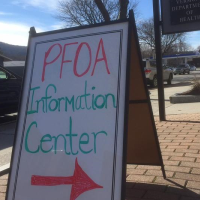EPA Tightens Limits on Industrial Chemical Found in Tap Water of Factory Towns
 PFOA center at Vermont Health Dept in Bennington (photo: Howard Weiss-Tisman, VPR)
PFOA center at Vermont Health Dept in Bennington (photo: Howard Weiss-Tisman, VPR)
By Michael Biesecker Associated Press
WASHINGTON (AP) — Federal regulators announced tighter guidelines Thursday for human exposure to an industrial chemical used for decades in such consumer products as non-stick pans, stain-resistant carpets and microwave popcorn bags.
The cancer-causing chemical perfluorooctanoic acid, known as PFOA, has been found in the tap water of dozens of factory towns near industrial sites where it was manufactured. DuPont, 3M and other U.S. chemical companies voluntarily phased out the use of PFOA in recent years.
Also at issue is the related chemical perfluorooctane sulfonate, or PFOS, used in firefighting foam.
The Environmental Protection Agency issued the stricter guidelines for the chemicals after years of pressure from public health experts and advocacy groups. The agency said the new limits were prompted by recent scientific studies linking PFOA and PFOS to testicular and kidney cancers, as well as birth defects and liver damage.
"EPA will continue sharing the latest science and information so that state and local officials can make informed decisions and take actions to protect public health," said Joel Beauvais, the EPA's deputy assistant administrator for the Office of Water. "This is an important part of our broader effort to support states and public water systems as we work together to strengthen the safety of America's drinking water."
Trace amounts of PFOA and PFOS can be detected in the blood of almost every American as the result of exposure through food and consumer products. But of specific concern to regulators is the risk posed to residents in the relatively small number of communities where higher levels of PFOA and PFOS have been found in public drinking water.
EPA now says long-term exposure to either chemical at concentrations above 70 parts per trillion could have adverse health impacts. That's significantly lower than the agency's prior advisory level based on short-term exposure of 400 parts per trillion.
Under the EPA's new guidance, water systems where concentrations of PFOA or PFOS are found above 70 parts per trillion are advised to promptly notify local residents and consult with their state drinking water agencies.
EPA said public notification is especially important for pregnant or nursing women because of the impact the chemicals can have on the development of fetuses and infants who are breastfed or drinking formula made with tap water.
In 2013, EPA ordered about 4,800 public water systems nationwide to test for PFOA. More than 100 cities and towns in 29 states had trace amounts of PFOA, but none exceeded 400 parts per trillion.
However, the new lower limit means that a handful of those communities will now qualify as having water with contamination levels above the advised threshold.
EPA's national survey also did not include many smaller communities located near sites where the chemicals were used for decades.
Hoosick Falls, New York, is located near a plastics plant and where the water supply system serves just 4,500 people, wasn't included in the testing. PFOA levels of 600 part per trillion were discovered in village wells in 2014 because residents demanded testing amid concerns about what they perceived as a high cancer rates.
More recently, testing turned up PFOA concentrations of about 100 parts per trillion in the drinking water of nearby Petersburgh, New York, and North Bennington, Vermont, which also had plastics plants. A second round of water testing in North Bennington recently yielded readings of up to 2,730 parts per trillion — nearly 40 times the EPA's new advisory limit.
To Learn More:
Deadly Chemical PFOA Found in Water of Factory Towns Nationwide (by Mary Esch, Associated Press)
Vermont Town Finds Its Water Contaminated with Corporate Cancer-Causing Chemicals (by Vivian Yee, New York Times)
Small New York Village Alarmed by Contamination of Water Supply by Teflon-Maker’s Toxic Chemicals (by Jesse Mckinley, New York Times)
Court Orders DuPont to Go to Trial 40 Times a Year to Face Thousands of Toxic Chemical Victim Lawsuits (by Jessica Dye, Reuters)
18 Unregulated Chemicals Found in a Third of U.S. Water Utilities Tested (by Noel Brinkerhoff and Danny Biederman, AllGov)
- Top Stories
- Unusual News
- Where is the Money Going?
- Controversies
- U.S. and the World
- Appointments and Resignations
- Latest News
- Musk and Trump Fire Members of Congress
- Trump Calls for Violent Street Demonstrations Against Himself
- Trump Changes Name of Republican Party
- The 2024 Election By the Numbers
- Bashar al-Assad—The Fall of a Rabid AntiSemite






Comments